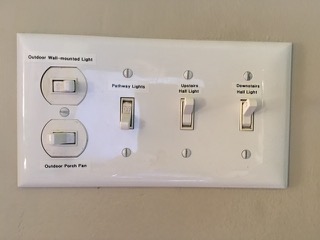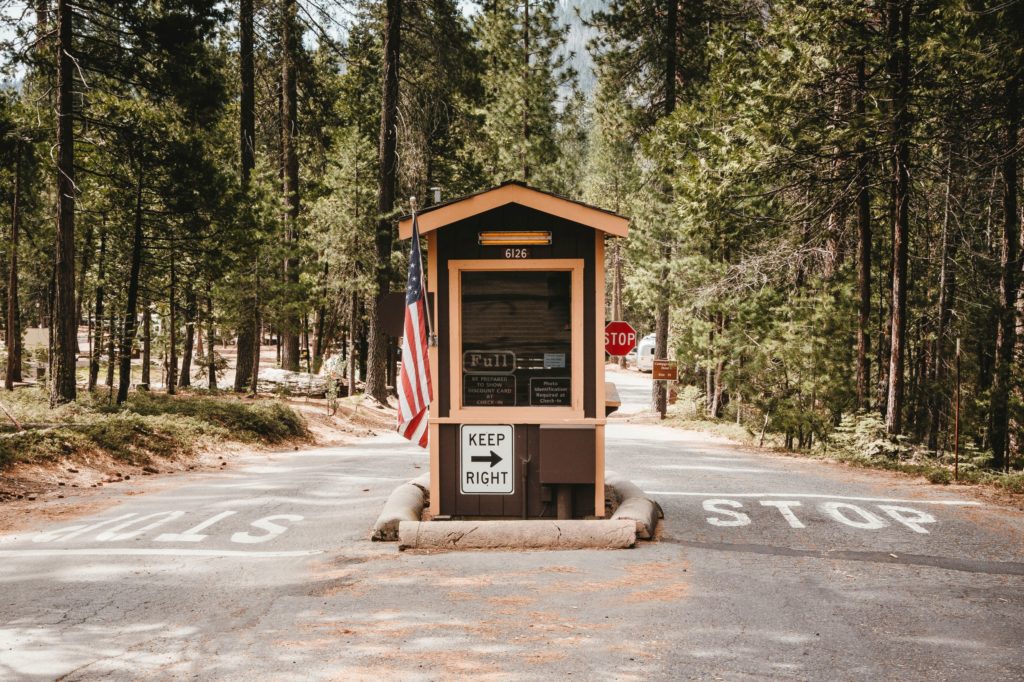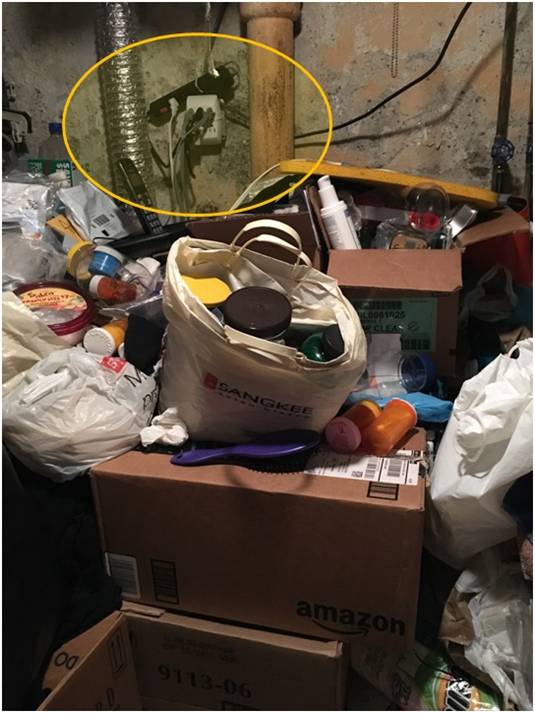As an organizer, I always follow my client’s lead and only suggest we work on areas THEY identify. Every once in a while, though, I notice an irritating situation that could easily be solved with a label.
This scenario came up a month ago while working in someone’s dressing area: her space has a number of zones with specific task lighting tied to a central panel.
As we were leaving the space, she went to turn off her make-up area light. Not knowing which switch controlled which light, she ended up flicking every switch, one by one, until she found the ONE she needed. Her heavy sigh told me this issue is chronic.
So we fixed her problem — right then and there.

Now, if you know the story of the cobbler whose kids went barefoot, you will understand that just because I see “problem areas” in other people’s homes all day, this does not guarantee that I am a ruthless problem-solver in my own home.
Spoiler alert: not every shelf, bin or basket in my home is labeled!
Truth is, not every shelf, basket or bin NEEDS to be labeled. If it is obvious what it is and if no one is having an issue finding what they need, then there is no problem. But confusion breeds stress.
That same day, I went home and noticed myself doing the same thing to two of our three kitchen switches. That’s when I decided to do for myself what I do for others! So I labeled our switchplate. It’s been a game changer. The only thing I had to tweak was what I called them; my daughter did not think “door” made sense so we revised the label and now everyone is happy.

Our kitchen is the hub of our home, but now that the weather is warmer, we are spending a lot more time on our front porch.
Fast forward to the other day, when my husband texted me to make sure I turned off the front pathway lights. Our guests had stayed late the night before, and he didn’t want to waste electricity. In the daylight, I could not see if the lights were on or off… Couple that confusion with another multi-switch panel, and my stress level was rising. Without a partner to check the outdoor fixture’s bulb, it was more exercise than I expected so early in the morning. I figured it out on my own, turned the pathway lights off and did what any organized person would do: I labeled each switch.

This time, my family approved of every label AND my daughter commented the next morning how helpful it was to know which switch controlled which hallway light. She had stayed up later than all — not unusual for teenagers — and knowing that we sleep with our door open at night to give our dog freedom, she didn’t want to wake us with a bright light at the top of the stairs.
My labels helped protect my investment of time, saved our daughter from waking us, and granted me an uninterrupted night’s sleep!
Think of where a label or two could help your household function a little better or brighter, or maybe even ensure a better night’s sleep for you.
Banish household confusion with a label or two; it’s illuminating!

First, let me confess: I am NOT what you might call an “Early Adopter” when it comes to technology.
I need to know that an app/program has been around a long time, is secure and is fast and easy to learn and use.
Here are 5 tech tools that meet those requirements. Use them daily to free up mental clutter, to run on time with appointments and projects, and to help you access information quickly.
You will enjoy the benefits of a calmer daily routine and the ability to access information speedily if you take a little effort to use one or more of these tech tools!

One of my favorite productivity experts, Laura Vanderkam, published her summer fun list this week, and it spurred me to create my own list. She encourages us to make time for “effortful” fun, ie things that require a little planning. That way, we don’t whittle the summertime away, wishing we had done more when Fall comes around.
I also wanted to view our summer fun list through the lens of saving money. Using Julie Morgenstern’s 4D approach, I thought about how we could “diminish” something, ie find the minimum effective dose. For example, should we pay $150 to see fireworks at Longwood Gardens or watch them for free at the local high school? Do we need to do the Phillies or would a minor league Blue Rocks game be just as fun?
So, here goes … my summer fun list!
I’ve already done the work to schedule most of these things, so now I can just sit back and let the fun happen. Happy summer everyone!

That can look like many things: maintaining a written planner, using and sharing an online calendar, time blocking, scheduling appointments as well as daily tasks, or creating a timeline for big events. And, while creating a timeline is a great way to keep track of any project or event that you are planning, it is a most valuable asset in managing a move.
Moving is uncomfortable and inconvenient at best, and downright exasperating and stressful at its worst. This is due to the infrequency and unpredictability of the process.
This isn’t an undertaking the average person practices over and over again throughout the year. We don’t move to a new home every week! Therefore, we don’t get the opportunity to hone and streamline each step of the process. And, even if we do sharpen our skills, there are some factors that just cannot be foreseen. Housing deals fall through, moving trucks get delayed, people in our lives have emergencies that need to be handled. Making a timeline cannot change these unexpected delays but it can put us in control of how to manage them and that’s what being organized is all about – being prepared.
Whether you are moving next year or this summer, it is never too late to create a timeline for your move.

A moving timeline may seem like extra work for your move right now, but the small bit of time taken to set up this management tool will support you throughout the process and keep you in the driver’s seat.
As an auction professional, I regularly have the opportunity to work with Professional Organizers and Senior Move Managers. These professionals provide a wonderful service helping client’s de-clutter their homes for a variety of reasons including preparation for sale, down-sizing & moving to a smaller living space or simply organizing their lives.
During the de-cluttering process, there is often a need to sell personal property and in some cases a great deal of property. Since auctions are a simple, efficient and often productive approach to selling, we can often help the same client. This is the wonderful connection between us.
I developed a passion for auctions as a child from my father. He loved auctions and would take me on his Saturday auction adventures to pretend he was helping my mother. He loved to buy at auction and mom did not appreciate clutter, so you can imagine the action at our home.
These auctions often had big crowds of people and enthusiastic bidding. It was exciting! I would hear energized bidders looking for a bargain. However, I was attracted to selling at auction as the price just went one direction. I have not come across another business negotiation where the price only goes higher. I loved the excitement of the auction environment as a child and still do today. However, the environment has changed.
I have heard these questions in recent years as we help clients looking to sell their property. A great many of these clients were at auctions forty, fifty or more years ago buying much of their art, furniture, antiques, decorative items and collections. They would often spend an entire day at the auction and there would be hundreds of people in attendance. They would see friends and enjoy the camaraderie.
I was reminded of the feeling when recently watching an old movie “North by Northwest”. There is a fascinating auction scene Alfred Hitchcock used in the story line. It showed bidding and activity at a high end auction over fifty years ago. The auction gallery was filled. People were sitting in every available seat and others were standing. There were no large screens displaying the auction item and no bidding by telephone or internet. There were no computers supporting the auction process at all. What a major difference!
Large screens, phone bidding and internet platforms have expanded the range and number of bidders dramatically. However, it does not look like it to auction buyers from many years ago turned into auction sellers as their lives have changed.
When asked where is everybody? Where are the bidders? I point out the number of ways the auctioneer is accepting bids beyond those from the smaller than they expected bidders attending in person.
I look toward the computers handing the bidding for each of the multiple
internet bidding platforms and explain each computer represents far more bidders than when you purchased in the crowded auctions many years ago. I look toward the staff members handling phone bidding and point out those strong bidders as well. There are also bids left with the office and on our web-site. I explain there is a larger geographic area represented and there are bidders watching the auction from not only our region but from the entire United States and around the world. I point out they have been able to see each item in a gallery of pictures for a month before the auction.
Once the auctioneer starts taking bids from the bidders in all these different ways (including from bidders in person like Alfred Hitchcock portrayed), it begins to make sense. Bidding at auction is even more exciting as it comes in so many ways from so many places!
There are a staggering number of people in the U.S. suffering from hoarding behavior. Individuals engage in excessive accumulating or have difficulty letting go of items, sometimes so severe that it interferes with normal activities of daily life. Rooms are no longer usable for their intended purpose, we see dining rooms cluttered with belongings not meals or tubs holding clothes not bathwater. Statistics estimate that 15 million people are dealing with this issue. In Philadelphia, the estimate is 31,000 -77,000.
A cleanout is the method most municipalities use to deal with hoarding. Reducing the volume of clutter to safer levels is thought to alleviate the problem and support the person. The reality is, without treatment and support for the individual, the rate of recidivism after a cleanout is nearly 100%. With the high cost of cleanouts and low rate of return, cities are beginning to pay attention to research findings.
Thanks to the research of doctors Frost, Steketee, Tompkin and Tolin, we are now understanding that cleanouts are “stuff-centered” and don’t address the issues buried below the surface. Simply removing clutter without addressing the underlying issues illuminates the reasons for high recidivism rates after cleanouts. This research is stimulating new intervention models. Being “people-centered” is the common theme. They each involve the person with hoarding behavior as key to the solution. Given that 92% of individuals diagnosed with Hoarding Disorder also have another co-occurring disorder, there is no one set solution.
The work is personalized and takes keen listening skills, creativity, flexibility, patience, and lots of compassion. Instead of focusing solely on the volume of clutter, a spotlight shines on the safety and well-being of the individual while working to reframe old thoughts and beliefs to reduce the dependence on acquiring and saving. There is no magic pill. Everyone involved understands this disorder has deep roots; the process takes time and relapses are as common as seen with over eating or drinking.

One of the new models is Harm Reduction (HR). Its goal is to reduce the risks associated with hoarding. Instead of talking about the “stuff” to get rid of, it asks the question, “How do we keep you safe in your home and maintain clear access for emergency staff and equipment if the need ever arises?” The (HR) process provides a support person that works with the individual identifying key health and safety concerns in the home. They also serve to document goals to alleviate the issues. From this information, they design and implement a strategy to address these issues over time.
One such organization that has adopted this (HR) model is the Philadelphia Hoarding Task Force (PHTF). The Task Force is a coalition of organizations that seek to improve outcomes for people who hoard while balancing the rights of the individual with the health and safety needs of the community. PHTF is introducing service providers to this model as a way to circumvent the costly and catastrophic consequences often seen with cleanouts and instead, create favorable long lasting results.
Consulting with its members from Licensing and Inspections and the Fire Department, PHTF has come up with 8 Benchmarks to follow to create healthier, safer homes. These benchmarks provide specific measureable goals that support, guide, and unify everyone involved. They address potential hazards regarding fire, tripping, limited access in or out of the home for the individual, emergency personnel and their equipment, avalanches, health issues and infestation. The benchmarks are as follows:
